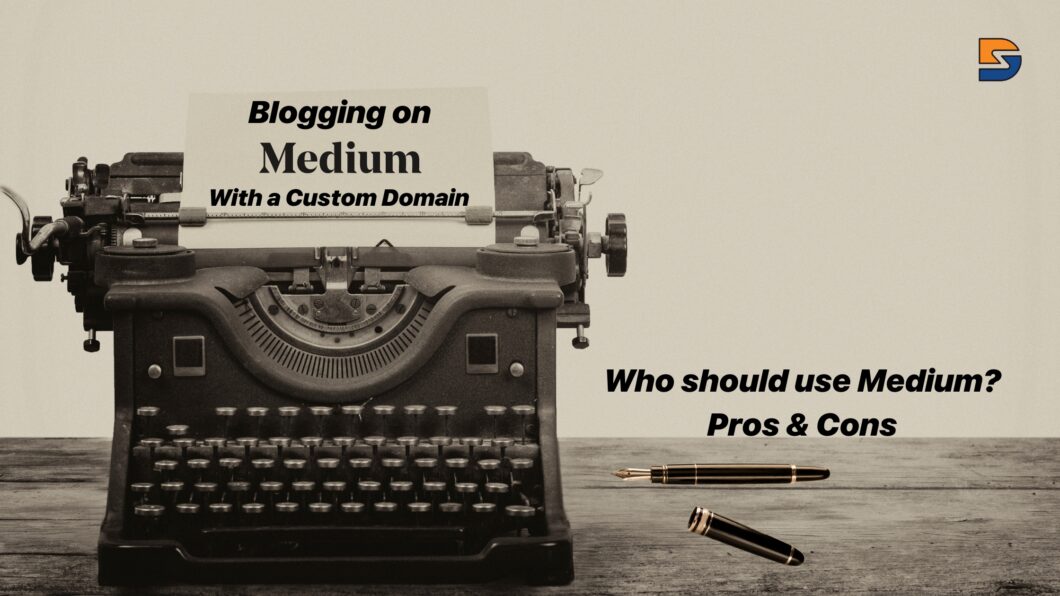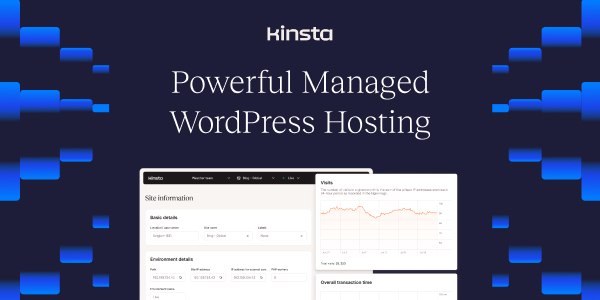1. Blogging on Medium is a great start for begginers.
2. If you’re a beginner wanting to try blogging with a minimum investment, Medium is the option.
3. You can connect a custom domain to your Medium profile or even a publication.
4. If you connect a custom domain, users will see your domain/brand name, not Medium’s.
5. For complex and ambitious projects, Medium might not be a right fit.
Medium is a great platform to repurpose content and drive more traffic or sales. In fact, you can even connect a custom domain and use a medium as a blog.
Medium is a clean and minimalistic design that gives a great user experience to end users, especially mobile users. Your stories published on Medium not only get organic traffic from search engines like Google, but even internal distribution can get you a lot of traffic. Medium has an algorithm to recommend stories to readers. I recently had to decide if I should use Medium as a primary CMS, and that’s when it occurred to me that Medium can be an amazing option for beginners to practice writing with a custom domain. And hence this post.
If you’re confused about whether you should connect a custom domain and use Medium as your primary blog, this post is for you.
Let’s get started.
What is Blogging on Medium?
Medium is like a big online magazine where anyone can write and share their ideas. It’s been around since 2012 and was started by one of the guys who made Twitter.
Some well-known brands use Medium for their blogs. For example, Toward Data Science writes about nerdy stuff like machine learning on Medium.
The Writing Cooperative shares tips for writers there too. Even big names like The Economist post articles on Medium sometimes.
To start blogging on Medium, you need to make an account. It’s pretty simple – you can use your Google or Facebook login or email.
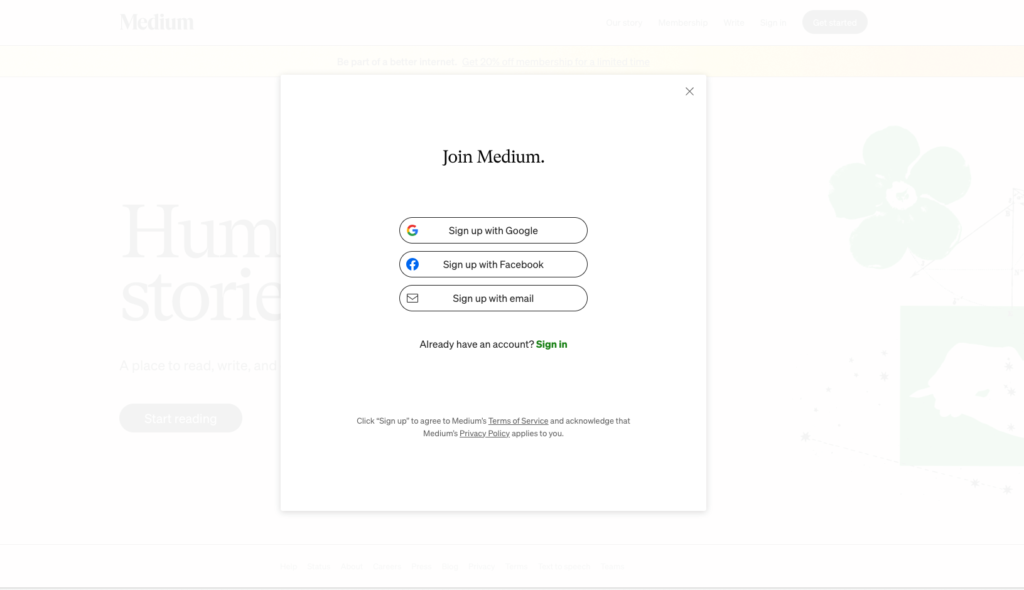
Once you’re in, you can start writing right away. The writing tool is easy to use, even if you’re not great with computers.
When you write on Medium, you’re not just shouting into the void. People can follow you, like your posts (they call it “clapping”), and comment. It’s kind of like Facebook for blog posts.
You can also follow topics you’re interested in, so you see more stuff about cooking or sports or whatever you like.
One cool thing about Medium is that you can make money from your writing. If people really like your posts, you might get paid via the Medium partner program.
But don’t quit your day job just yet – most people take a lot of time before they make a ton of cash this way. However, that’s not the only way you can make money on Medium.
Medium is big on looks. They want posts to be easy on the eyes. So, use big, eye-catching photos at the top of your posts. Break up your writing into short paragraphs. Use headers and bold text to make important stuff stand out.
If you want people actually to read your stuff, you need to write often. Successful Medium writers usually post a couple of times a week. But don’t just vomit words onto the page – take time to edit and make your posts good.
Medium isn’t just about writing. It’s also about distributing your posts. The more you distribute, the more you grow, on and off Medium.
Blogging on Medium is about sharing your ideas with the world. Whether you’re writing about your passion for vintage toasters or your thoughts on the economy, there’s probably an audience for it on Medium.
Who should be blogging on Medium?
The whole point of writing this post is to educate beginners who are looking for affordable options to start a blog. Medium can be a great option if you’re such a beginner.
You have to take care of only two expenses:
- Medium membership ($5/mo) &
- A custom domain
If you want to simply test if blogging is for you, or learning the principles of writing or simply creating a portfolio without worrying about web hosting, blogging on Medium with a custom domain is the best option. It looks professional, and you’ll feel committed because of the investment.
Bottom line:
If you’re a beginner, wanting to learn and apply your writing skills, Medium with a custom domain is the best thing your money can buy.
SEO benefits of blogging on Medium with a custom domain
According to Moz, Medium has a Domain Rating of 95. This means that out of 100, Medium has a trust score of 95. Domain rating is nothing but how credible a domain is in terms of SEO.
When brands publish content on Medium with a custom domain, they have solved the domain rating problem.
Even though they have connected a custom domain to their Medium profile or publication, it’s still Medium’s DR that plays a major role in the background.
Let me make it simple for you.
When you don’t connect a domain to Medium, this is what your profile URL looks like.
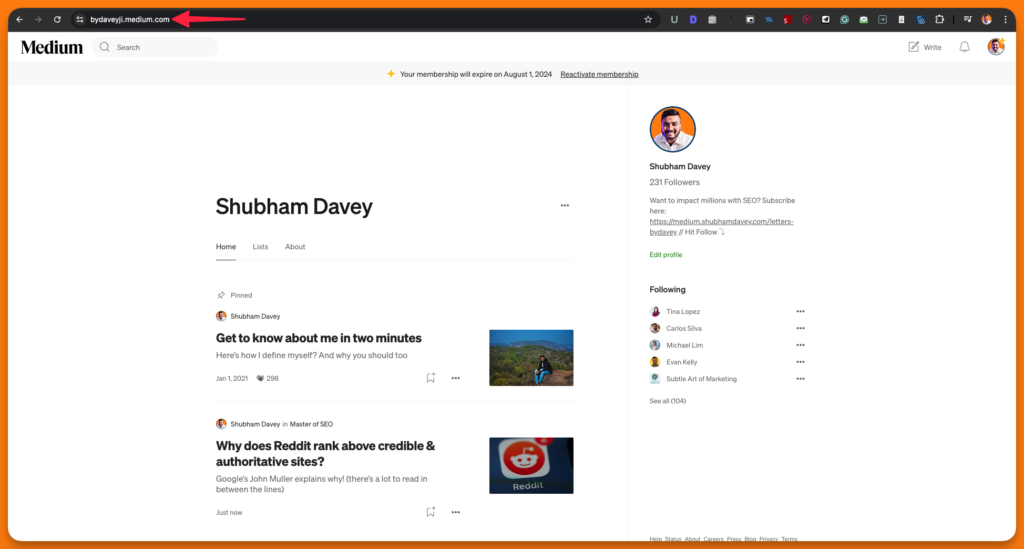
This is what the URL of a Medium publication looks like without a custom domain connected.
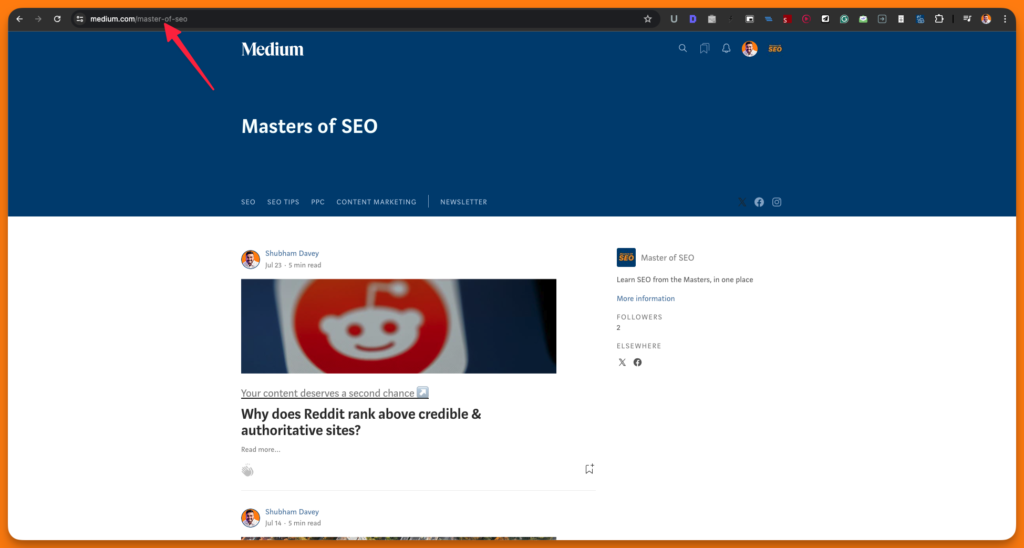
When you connect a domain to your Medium profile or a publication under your Medium profile, the URL changes to the domain you have connected.
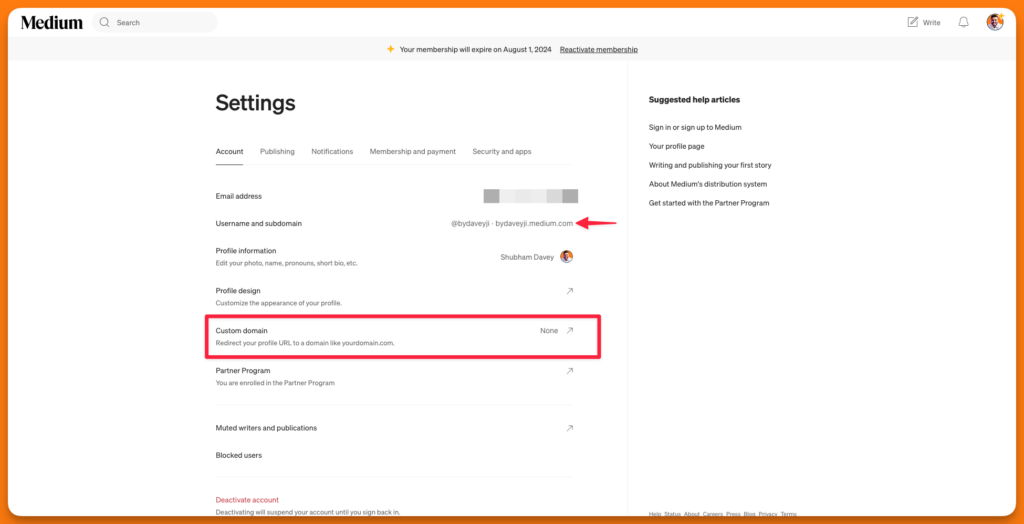
Once you connect a domain to your Medium profile/account, the system will simply redirect the traffic from the default URL (shown above) to your custom domain.
Imagine a forwarding feature where you call a number that has forwarded calls to another number. When you make a call, your call still connects to the number first. Since the call-forwarding feature is enabled, it redirects to the new number. So systematically, your call is connected to the first number and then redirected to the second number.
The same happens with domain redirects.
In this example, when you connect a custom domain, the traffic first goes to “https://bydaveyji.medium.com/” and then is redirected to “https://bydaveyji.com/” (assuming I own this domain and have connected it to my Medium profile)
Since the traffic will first pass through Medium’s default URL, Medium’s domain rating will be considered. At least theoretically, this is what happens.
How fruitful is blogging on Medium with a custom domain?
I’m not against using Medium as a blogging platform. But this post is for those who want to use Medium with a custom domain, so before you do that, you should be aware of the pros and cons of blogging on Medium with a custom domain.
Pros
- Easy to set up: It’s a piece of cake to set up. You don’t need to be a tech whiz to get your blog up and running.
- Quick Results: You get to piggyback on Medium’s existing crowd. There are loads of people already browsing Medium, so you might catch some eyeballs.
- Minimalistic Design: It looks slick without much effort. Medium’s design is clean and professional, so your blog automatically looks good.
- Good for non-tech-savvy users: You don’t have to deal with the tech headaches. No need to worry about hosting, security updates, or other backend stuff.
- Custom Domain: You can still use your own web address. This means people see your brand name in the URL, not Medium’s.
- Low investment: It’s cheaper than building a whole website from scratch. You save money on web design and hosting.
- Monetizable platform: You can make some cash from your writing. Medium has a partner program where you can earn money if people read your stuff.
- Easy collaboration: It’s easy to collaborate with other writers. If you want to team up on a blog, Medium makes it simple.
- Only Important KPIs: You get some basic stats about your posts. You can see how many people are reading and engaging with your content.
- Quick credibility: It puts your writing next to big-name publications. This might make you look more legit by association.
Cons
- Limited design flexibility: Medium’s minimalist aesthetic is great for readability, but it severely restricts your ability to customize your blog’s look and feel. You can’t add unique branding elements, change layouts, or create a distinct visual identity.
- No true homepage: As you mentioned, Medium doesn’t offer a traditional homepage. This makes it harder to create a strong first impression or showcase your best content to new visitors.
- Lack of sidebar and widgets: The absence of a sidebar limits your options for promoting products, capturing email signups, or displaying other important information without interrupting the reading experience.
- Restricted monetization options: While Medium does offer a Partner Program, you have limited control over how you monetize your content. You can’t easily integrate display ads, sponsored content, or your own products.
- No access to visitor data: Medium provides only basic analytics. You miss out on valuable visitor data and behaviour insights that could inform your content strategy and marketing efforts.
- Limited SEO control: While you can use a custom domain, you still lack full control over crucial SEO elements like metadata, URL structure, and internal linking.
- Content ownership concerns: Though you retain rights to your writing, Medium ultimately controls the platform. They could change policies or even shut down, potentially affecting your content’s accessibility.
- Difficulty building a unique community: Medium’s ecosystem makes it challenging to foster a dedicated community around your specific blog. Readers are more likely to engage with Medium as a whole rather than your individual publication.
- No plugin functionality: Unlike self-hosted platforms, you can’t extend your blog’s functionality with plugins or custom code to add features like contact forms, e-commerce integration, or membership areas.
- Limited email marketing integration: Building an email list directly from your Medium blog is difficult, hampering your ability to nurture leads and maintain a direct connection with your audience.
- Potential brand dilution: Your content appears alongside numerous other articles, potentially diluting your brand’s impact and making it harder for readers to focus solely on your message.
Should you still start Blogging on Medium?
While Medium is a great platform to start blogging, it has its own downsides as well. Especially if you want to move out of Medium, along with content, it will be a hell of a task. If you want better control of your site and more monetization options, consider WPX or Kinsta for hosting your website.
I still want to emphasize using Medium for blogging with a custom domain, but only if you’re not too serious about blogging. For more complex and ambitious projects, you will need better control. This control is not available on Medium. Publications like The Writing Cooperative have a custom domain connected to Medium, but that’s a story for another post.

